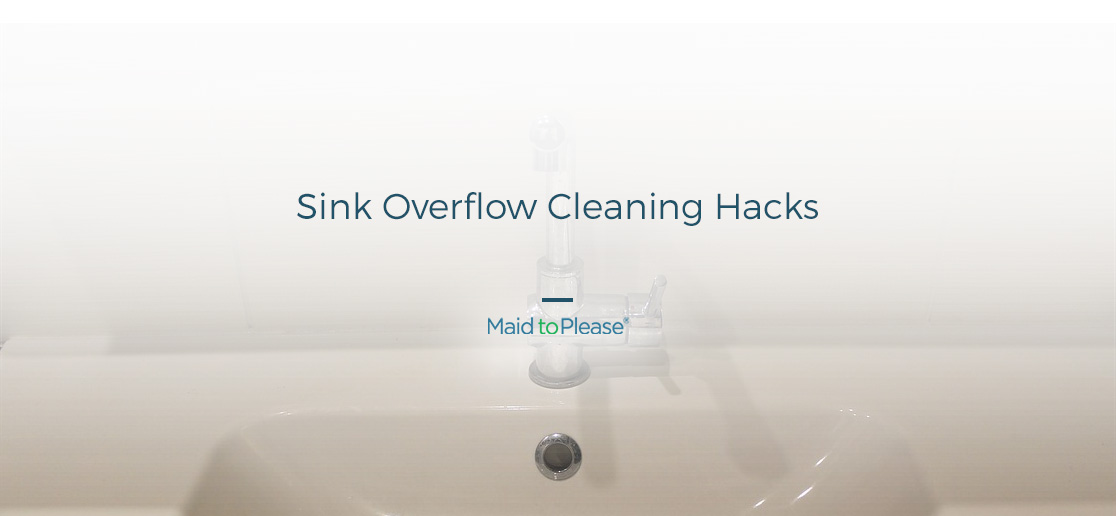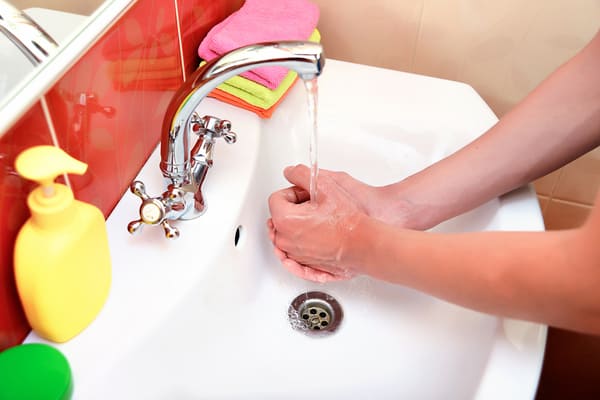To clean the overflow hole in a sink, use a mixture of baking soda and vinegar followed by hot water. A flexible brush can help scrub away any grime.
Keeping your sink in pristine condition involves regular maintenance, including the often-overlooked overflow hole. This small opening prevents water from spilling over the edges of your sink, but it can become a haven for bacteria and mold if not cleaned properly.
Dirt and debris accumulation may not only cause bad odors but can also lead to decreased efficiency in water drainage. Thus, ensuring that the overflow hole is kept clean not only maintains the usability of your sink but also contributes to the overall hygiene of your kitchen or bathroom. Simple household items such as baking soda, vinegar, and hot water, combined with a proper cleaning tool, can make this task easy and effective. Regular attention to this small detail helps prevent larger plumbing issues and keeps your sink looking and smelling fresh.
Introduction To Sink Maintenance
Sink maintenance is essential for a clean and functional kitchen or bathroom. Proper care prevents clogs and odors. A well-kept sink also adds to the overall aesthetics of the room. One often overlooked element is the overflow hole. Tending to this part is critical.
Understanding The Role Of The Overflow Hole
The overflow hole has a key function. It prevents water from spilling over. It also allows air into the drain. This air helps water flow quickly and smoothly. Without it, your sink could turn into a mini pool!
Recognizing The Importance Of Regular Cleaning
Cleaning the overflow hole should be part of your routine. Regular cleaning stops blockages and nasty smells. It stops bacteria and mold growth too. A clean overflow hole maintains a hygienic and fresh sink.
Here are steps to clean the overflow hole effectively:
- Turn off the water supply.
- Remove any visible debris.
- Use a bottle brush to scrub inside the hole.
- Prepare a mixture of warm water and mild detergent.
- Pour the mixture into the hole.
- Rinse with clean water.
- Dry the area with a soft cloth.
Remember, clean sinks ensure safe and pleasant spaces at home. Don’t neglect the small parts like overflow holes.

Credit: maidtoplease.com
Identifying The Overflow Hole
Your sink’s overflow hole is a critical part. It prevents water from spilling out. Many overlook this feature during cleaning. It’s important to keep it clear. Let’s find where it is. Learn about its parts. This helps maintain a spotless, functional sink.
Locating The Overflow Hole In Different Sink Types
Each sink type has a unique build. Finding the overflow hole might differ. Commonly, it’s on the inner side of a basin. For bathroom sinks, it’s often opposite the faucet. In kitchen sinks, it may be under the rim. Make sure you spot it to ensure proper maintenance.
- Bathroom Sinks: Look under the rim or opposite the tap.
- Kitchen Sinks: It may be more hidden, under the rim near the top.
- Utility Sinks: These might lack an overflow, but always check.
Anatomy Of A Sink: Components And Their Functions
Understanding a sink’s design enhances your cleaning routine. The components work together efficiently.
| Component | Function |
|---|---|
| Basin | Holds water for various tasks |
| Faucet | Controls the water flow |
| Drain | Removes used water |
| Overflow Hole | Prevents water overflow |
| Sealant | Prevents leaks around the edges |
A clean overflow hole is vital for functionality. It keeps the water where it should be. Regular checks and maintenance ensure smooth operation.
Preparing For The Cleaning Process
Preparing for the Cleaning Process is the first crucial step to ensure a smooth and effective cleanup of your sink’s overflow hole. Before diving into the task, it’s important to have all your cleaning supplies ready and to take appropriate safety measures. A well-prepared approach can save time and protect you from any unexpected mess or accidents.
Gathering Necessary Cleaning Supplies
Here is a list of supplies you will need:
- Vinegar: A natural cleaning agent that helps to dissolve grime.
- Baking Soda: Works with vinegar to fizz away dirt.
- Old Toothbrush: Perfect for scrubbing tight spots.
- Pipe Cleaner or Soft-Wire Brush: For reaching down into the overflow hole.
- Rubber Gloves: To protect your hands.
- Bucket or Bowl: For mixing solutions and catching drips.
- Cloth or Sponge: To wipe surfaces and clean up spills.
Safety Measures And Precautions Before Cleaning
Ensure a safe cleaning experience with these tips:
- Put on rubber gloves to protect your skin from dirt and cleaning products.
- Avoid mixing different chemical cleaners to prevent harmful reactions.
- Make sure the room is well-ventilated to avoid inhaling fumes.
- Keep all cleaning supplies away from children and pets.
- If using commercial cleaners, read and follow the manufacturer’s instructions carefully.
Manual Cleaning Techniques
Overflow holes can collect grime over time. Keeping them clean ensures your sink drains well. This post outlines manual cleaning techniques for your sink’s overflow hole. Simple tools and homemade solutions do the trick.
Using A Bottle Brush For Mechanical Cleaning
A bottle brush is your go-to tool for this task. Follow these steps:
- Choose a bottle brush that fits snugly in the overflow hole.
- Insert the brush into the overflow hole and move it in and out.
- Rotate the brush to clean all sides of the hole.
- Rinse the hole with water to wash away loose debris.
Implementing A Diy Cleaning Solution
Create a homemade cleaning solution with common household items. Mix these ingredients:
- Baking soda – a natural abrasive
- Vinegar – for breaking down grime
- Hot water
Here’s how to use your solution:
- Pour a small amount of baking soda into the overflow hole.
- Add vinegar and allow the mixture to fizz.
- Wait for 5-10 minutes as the solution works.
- Flush the hole with hot water to clear residue.
Chemical Cleaning Approaches
Dealing with a clogged overflow hole in your sink can be a tricky task. Chemical cleaning approaches are reliable solutions that break down the gunk and residue. These methods are often quick and effective.
Selecting The Right Chemical Cleaners
Choose cleaners that are safe for your type of sink. Check labels for compatibility with sink materials like porcelain or stainless steel. Environment-friendly options are available too.
- Drain cleaners specifically designed for sink clogs
- De-clogging gels with a thicker consistency to cling to obstructions
- Biodegradable cleaners for a greener approach
Application Tips For Chemical Cleaners
For safety and effectiveness, follow these steps:
- Wear gloves and ensure good ventilation.
- Read instructions on the cleaner.
- Pour the recommended amount into the overflow hole.
- Wait for the specified time; usually, this is 15-30 minutes.
- Rinse thoroughly with hot water.
Never mix different chemicals; dangerous reactions may occur.
Confirm a clean spillway with a simple water test.
Natural And Eco-friendly Alternatives
Let’s explore natural and eco-friendly alternatives to clean your sink’s overflow hole. These methods are safe for the environment and easy to use.
Leveraging Baking Soda And Vinegar
Combining baking soda and vinegar creates an effective cleaner. This natural duo works wonders for blocking bad smells and clogs. Follow these simple steps to use them:
- Sprinkle 1/4 cup of baking soda into the overflow hole.
- Pour 1/2 cup of white vinegar right after.
- Let the mixture foam and bubble for a few minutes.
- Rinse with hot water to wash away residue.
Environmental Considerations And Benefits
Using these natural ingredients has notable environmental benefits:
- They are biodegradable and don’t harm aquatic life.
- They minimize the use of harsh chemicals in our waterways.
- Vinegar and baking soda can reduce your carbon footprint.
By choosing these methods, you’re not only cleaning the overflow hole but also protecting our planet.
Preventing Clogs And Buildup
Keeping your sink’s overflow hole clean ensures water flows freely. Preventing clogs is not just about reacting to blockages; it’s about ongoing maintenance and proper usage. A clean overflow hole stops bad odors and prevents damage to your sink and plumbing. Let’s ensure your sink stays pristine with a few handy tips.
Regular Cleaning Schedules
Implement a consistent cleaning routine. This avoids buildup in the overflow section of your sink.
- Weekly: Flush the overflow with hot water.
- Monthly: Use a mixed solution of vinegar and baking soda.
Record these tasks on a calendar. It helps you remember the regular cleaning schedule.
Best Practices For Sink Usage
Avoiding clogs is simple with the right habits. Be mindful of what goes down your sink.
| Do | Don’t |
|---|---|
| Run hot water after use | Dispose of oils in the sink |
| Clean debris with a strainer | Drop small items like rings |
By preventing items from entering the overflow, you safeguard the sink’s functionality.

Credit: www.reddit.com
Troubleshooting Common Issues
At one point or another, your sink’s overflow hole may give you a headache. Persistent clogs or unusual behavior in your sink’s overflow can be a nuisance. But worry not! Below are steps to tackle some of the most common issues, ensuring your sink stays pristine and fully functional.
Dealing With Persistent Clogs
Before reaching for chemical cleaners, consider some safer alternatives:
- Boiling water: Pour it down the hole to dissolve organic matter.
- Baking soda and vinegar: A natural combo that breaks down gunk.
- Manual cleaning: Use a small brush to scrub away debris.
If these steps don’t clear the clog:
- Remove the sink stopper.
- Use a plumber’s snake to reach deeper blockages.
- Rinse with hot water to clear loosened material.
Remember, frequent clogs may indicate accumulation of solids. Regular maintenance keeps them at bay.
When To Seek Professional Help
Some issues require an expert touch. Spot these signs:
| Issue | Action |
|---|---|
| Recurring clogs despite cleaning | Call a plumber |
| Water damage around the sink | Seek immediate help |
| Unpleasant odors that persist | Professional cleaning may be needed |
Professionals deal with complex plumbing systems with ease. If home remedies fail, or you notice water leaks or damage, it’s time to call in a professional.
Visual Guide: Step-by-step Cleaning
Your sink’s overflow hole is a handy feature that prevents spills. But did you know it can harbor mildew and grime? Keep it sparkling with these quick steps.
Infographic: Cleaning The Overflow Hole
Visual aids can make cleaning simpler. Check out our infographic on cleaning your sink’s overflow.

Video Tutorial Recommendations
Watch experts do it first! Here’s a list of recommended videos for a deep dive into the process.
- “Sparkling Sinks: Overflow Cleaning” – SinkCleaningPros
- “Quick Overflow Clean-Up” – HomeCareBuzz
- Gather supplies: Gloves, vinegar/baking soda, bottle brush.
- Turn off sink: Prevent water flow during cleaning.
- Mix solution: One part water to one part vinegar.
- Apply mixture: Pour into the hole; let it fizz.
- Scrub: Use the brush to clean inside the hole.
- Rinse: Flush out the solution with warm water.
- Repeat if needed: Tough grime might need a second go.
Maintaining Sink Hygiene Post-cleaning
Congratulations on cleaning your sink’s overflow hole! Maintaining this newly achieved cleanliness ensures a healthy, fresh sink every day. Let’s keep that sparkle with simple, effective routines.
Daily Sink Care Tips
Consistent daily care prevents grime build-up. Follow these quick steps to keep your sink gleaming:
- Rinse well after each use to clear residue.
- Wipe surfaces with a soft cloth or sponge.
- Use a mild detergent for a spotless finish.
- Ensure proper airflow for drying by keeping the overflow hole clear.
The Role Of Regular Inspection
Regular checks keep minor issues from becoming big problems. Here’s a simple inspection routine:
- Examine the overflow hole weekly for debris.
- Keep an eye on water flow; slow drainage may indicate a block.
- Address any mold or bad odors immediately.
Remember, a clean overflow hole is crucial in sink maintenance. Quick checks save time and effort in the long run.
Conclusion: The Benefits Of A Clean Sink Overflow Hole
Maintaining a clean sink overflow hole offers more than just aesthetic appeal. It ensures water flows freely, preventing potential clogs and unpleasant odors. Let’s take a moment to appreciate the full range of benefits that come with keeping this small but crucial part of your sink tidy.
Summarizing The Key Takeaways
Throughout our guide on cleaning the sink overflow, several important points stand out:
- Regular cleaning prevents build-up, which in turn avoids clogs and foul odors.
- A variety of tools and solutions can effectively clear out debris and residues.
- DIY approaches are both cost-effective and convenient for maintaining a pristine overflow hole.
Encouraging Ongoing Sink Maintenance
Establishing a simple routine for sink upkeep can save you time and money. Here’s a brief maintenance checklist:
- Inspect your sink regularly for any signs of overflow blockage.
- Clean the overflow hole once a month to prevent build-up.
- If you spot minor clogs, address them promptly to prevent larger issues.
Remember, a clean overflow contributes to a fully functional and hygienic sink.

Credit: www.merrymaids.com
Frequently Asked Questions Of How To Clean Overflow Hole In Sink
Why Should I Clean My Sink’s Overflow Hole?
Regular cleaning prevents blockages and eliminates foul odors. It ensures that water flows smoothly and your sink remains hygienic.
What Materials Do I Need To Clean The Overflow Hole?
You’ll need a small bottle brush, bleach or vinegar, and warm water. Wear gloves to protect your hands during the process.
How Often Should The Overflow Hole Be Cleaned?
Ideal cleaning frequency is once every couple of months. However, adjust depending on usage and if odors arise.
Can Baking Soda And Vinegar Clean Overflow Holes?
Yes, the combination effectively removes buildup. Pour them in, wait for the reaction to subside, then rinse thoroughly.
Conclusion
Keeping your sink’s overflow hole clean is simple yet crucial for hygiene and preventing odors. Remember, a mixture of baking soda and vinegar can work wonders. Regular maintenance avoids clogs and ensures a fresh, functioning sink. Embrace this easy routine to keep your sink in top condition, and enjoy a cleaner, fresher kitchen or bathroom space.

